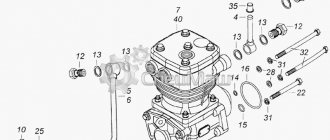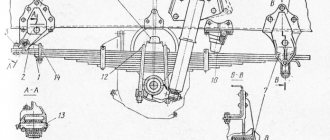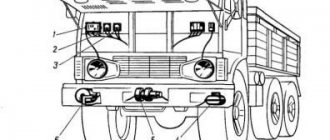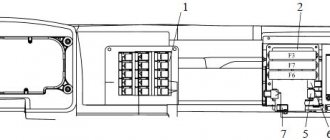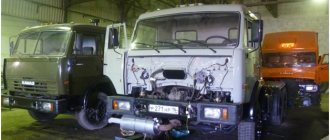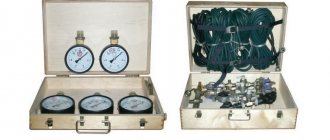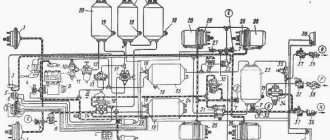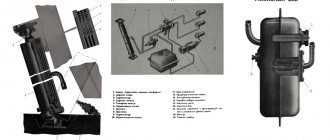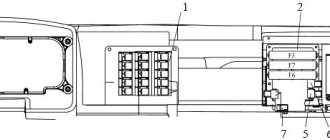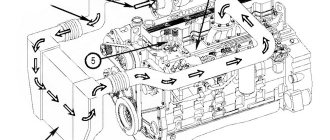At the request of the driver, I decided to explain in the most simplified way how the KAMAZ stove motors work. This scheme is used on many cars with a dual-engine interior heating system.
The general scheme is this:
You can draw it even easier. The key is drawn “back view” from the pin side.
How it works? Elementary... A permanent purple plus “hangs” on the first motor. But there is no constant mass on it. On the second motor there is a constant minus (ground) (red). But there is no permanent plus on it. The whole “trick” lies in applying these pros and cons to these motors. This is what drives the key. So... 1. The first position of the keyboard - all circuits are open. 2. The second position of the keyboard is LOW SPEED. The key connects pink to green1, which through a jumper to green2 connects to blue. That is, in the end, pink closes with blue. There is a series connection of the motors and they work “at half strength”.
3. The third position of the key is HIGH SPEED. For the first motor, the key connects blue with black, going to ground. For the second motor, the key connects the pink one with the purple one, which has constant power. As a result, both motors operate independently at full power.
This is how this canoe warms our eggs.) Don’t kick me for the drawings. I drew as best I could.) Have a quick spring everyone!
The heating system is designed to maintain optimal temperature conditions in the cabin when the ambient temperature drops. Electric motors 1 (Fig. 327) pump air passing through the cabin heater radiator. When installing electric motors, pay attention to the direction of rotation of their shafts.
Rice. 327. Electrical diagram of heating systems, sound alarms and windshield wipers: 1 - heater electric motor; 2 — switch for electric motors of the heater; 3 — windshield wiper; 4 — heater motor relay; 5 - fuse 13.3722 (7.5 A); 6 - fuse PR 310 (10 A); 7 — windshield washer switch; 8 — windshield washer, 9 — windshield wiper switch; 10 — combined light switch; 11 — sound signal (buzzer); 12 - tone signals; 13 — sound signal relay; I - to terminal AM of the instrument switch and starter; II - to the short circuit terminal of the instrument switch and starter; III - to the brake signal relay; IV - to the signaling unit
The system uses a reversible electric motor ME 250. When the positive pole of the voltage source is connected to the red wire of the electric motor, right rotation is activated, and the negative pole - left rotation.
Features and Important Elements
The KAMAZ vehicle, whose cooling system is practically no different from the classic one, works optimally. In case of deviations, the car’s engine faces considerable trouble. The composition of the main elements of the system is almost the same as that of a passenger car:
- cooling radiator;
- water pump;
- pipes;
- thermostats;
- cooling Fan.
One difference from the cooling system of non-truck vehicles is immediately visible - the presence of 2 thermostats. This is due primarily to the structural features of the engine. The V-8 has two cylinder heads positioned at an angle of less than 900 (hence the name). The next distinctive feature is the shutters on the cooling radiator. During the cold season, they are in the closed position and allow the engine to quickly warm up.
The cooling system (KAMAZ 740) includes a hydraulic fan clutch. The controlled drive allows you to automatically adjust the fan speed, thereby intensively cooling the engine.
Heater and wiper
The interior of the KamAZ 5320 vehicle is equipped with an autonomous heater, which allows the vehicle to be used at sub-zero ambient temperatures. The circulation of warm air is carried out by an electric fan. The fan motor has two rotation speeds.
The windshield is cleaned by electrically driven windshield wipers. The windshield wiper motor has two operating modes. The electric motor is controlled using a switch located on the front panel of the cabin.
Cooling system operation diagram
The cooling system (KAMAZ 740) has a typical diagram, with the help of which it is easy to imagine and understand the main points of operation. The figure clearly shows that the car’s cooling system is closed with forced circulation of antifreeze. The speed of movement is dictated by the water pump (30). The coolant first flows into the cavity of the left bank of cylinders, and then through the tube into the cavity of the right bank of cylinders.
Once the fluid passes through the cylinder heads, it will naturally heat up. The next element on the way will be the thermostat (17). Here, depending on the degree of heating, the liquid will go either back to the pump (small circle) or to the cooling radiator (10). The radiator (usually 3 or 4 rows) actively cools the antifreeze and completes the large circle, directing the coolant to the pump.
The cooling system diagram (KAMAZ) is shown in the figure. There is also an expansion tank (21) with a cover (22) and a liquid level control valve (20). The fan and clutch assembly (9) controls the speed and direction of coolant flow. It turns on at a temperature of 850C. In general, the antifreeze temperature during engine operation should be maintained in the range of 85-900C. To improve the direction of air flow through the fan, a diffuser is provided. If the temperature of the liquid in the cooling system exceeds (980C), the control light on the instrument panel will light up.
Relay box behind switch panel
p, blockquote 8,0,0,0,0 —>
Scheme
p, blockquote 9,0,0,0,0 —>
p, blockquote 10,0,0,0,0 —>
Purpose
- ABS relay
- Starter Interlock Relay
- Brake relay
- Clutch relay
- Fuel heating relay
- EFU relay
- Daytime running light relay
- Platform Stop Sensor Relay
- Rear fog lamp relay
- Oil separator relay.
Weaknesses of the cooling system
First, let's look at what can happen to the cooling system of a truck. There really aren't that many problems:
- flow;
- antifreeze overheating;
- hypothermia;
- coolant entering the oil system.
Antifreeze leaks primarily occur through the connections of the pipes, and lastly from the destruction (crackling) of rubber hoses. Therefore, one of the weak points of the system is the pipes. A KAMAZ whose cooling system malfunctions begins to “suffer” and overheat. After all, if the coolant level drops, the overall heating of the system increases. It's not far from overheating here. To eliminate a leak, it is important to carefully tighten everything and pressurize the entire system.
The second weak point can be identified as thermostats. If this element fails, it is possible to either overheat or overcool the engine. It depends on what position the valve is stuck in. If the thermostat is open, the liquid “walks” in a large circle through the radiator. In the case of a cold engine, this prevents the engine from heating up. If the blinds are also open, the engine can be overcooled.
If the thermostat is closed, antifreeze does not enter the radiator and heats up quickly enough on a hot engine. For some time, a fan (KAMAZ) saves the situation. The cooling system stops coping and first the antifreeze overheats, and then the engine.
The third in line of weak points will be the cooling fan with clutch. If it fails, the system will not work with passive cooling through the radiator. If you look after your car and do timely preventive inspections, checking “suspicious” areas, then you shouldn’t expect any problems from the cooling system.
Cooling radiator (KAMAZ)
Let's consider all the main components of the cooling system separately. Let's start with what first catches your eye - the radiator.
The cooling system (KAMAZ 5320) includes a 3- or 4-row cooling radiator. It is made according to the classic type and represents:
- the lower tank, to which the outlet pipe fits;
- a central system of tubes arranged in several rows;
- upper tank with inlet pipe.
Radiator mounting is three-point. It is secured on both sides with brackets, which in turn are connected to the frame side members through shock-absorbing elements. The lower radiator mount is connected to cross member No. 1 of the frame.
A special feature of the radiator structure (KAMAZ) is the presence of blinds. This is a mechanical system of metal plates that blocks access to air flow through the radiator. The blinds are controlled by a simple cable drive directly from the cabin. If the handle is pulled out, the blinds are closed; otherwise, the blinds are open. Thanks to this, the engine warms up faster in the cold season.
General information about the scheme
The electrical circuit of KamAZ 5320 is made according to the single-wire principle. The negative contact is the car body. The negative terminal of the battery and the negative terminals of the devices are attached to it. The plus of the battery is connected to consumers using copper wires.
IMPORTANT: To avoid short circuits in the vehicle’s on-board network, the wires are equipped with insulation that is resistant to moisture and temperature changes.
Electrical equipment includes several systems simultaneously:
- External lighting;
- Starting the power unit;
- Power supply for electrical equipment;
- Light signaling;
- Autonomous heater;
- Windshield cleaning;
- Instruments and control lamps;
- Salon lighting.
Fan
The cooling fan of a KAMAZ vehicle is installed on the hydraulic coupling shaft and is externally represented by five blades. Depending on the engine temperature, the clutch automatically turns on and off. The fan, according to these inclusions, either also works, or, in the case of a non-working fluid coupling, passively rotates under the influence of the air flow.
For more efficient airflow, the engine cooling system (KAMAZ) has a fan casing. It is made of thin metal sheet by stamping. Thanks to it, air effectively flows only to the radiator without side suction.
Light signaling
The system is necessary for safe use of the vehicle on public roads. Using the system, the driver indicates a maneuver for other road users.
Light signaling consists of:
- Rear and front lights;
- Road train lamps;
- Turn signal switch;
- Hazard switch;
- Relays and fuses;
- Brake light switch.
REFERENCE: The light alarm is equipped with a socket for connecting trailer wiring.
Cooling system fluid coupling
The cooling system design (KAMAZ) includes such an important element as a fluid coupling. The main purpose of this device is to transmit torque from the crankshaft of a car engine to the cooling fan. In the event of a sudden change in torque, the fluid coupling dampens vibrations, and the fan always runs smoothly, without jerking.
Structurally, a fluid coupling consists of two wheels rotating on a shaft through bearings enclosed in a housing. The number of blades is different: there are 33 on the driver, and 32 on the driven one. Between the blades of the fluid coupling there is an internal cavity, which is the working one. It is through the working cavity that torque is transmitted when it is filled with oil.
In order for the hydraulic coupling of the cooling system to work, it is necessary that engine oil enters it. This happens thanks to the switch, which has three positions. 3 switch fixations correspond to three fan operating modes:
- auto;
- constant fan on;
- the fan is completely turned off, the clutch does not transmit rotational torque from the crankshaft.
In automatic mode, the cooling system (KAMAZ Euro 2) operates according to the scheme developed by the designers. That is, up to a coolant temperature of 860C, the oil does not enter the working cavity of the fluid coupling and the fan is turned off. And when the temperature rises, the switch opens and oil enters the fluid coupling, thereby turning on the fan.
If the clutch switch is faulty (engine overheated), it is recommended to set it to the position with the fluid clutch constantly opening. And after eliminating the malfunction, return to automatic mode. For cases when the car overcomes deep fords, it is recommended to set the switch position to the clutch closed state.
Starter relay KamAZ-5320
The equipment of the truck, in accordance with the starter connection diagram, includes the following elements: electrical supply, light signaling, internal and external lighting, special measuring devices, heating system, engine starting system.
All trucks of the KamAZ model have a special device St-142b. To start the device, you need to rotate the device to a certain position. Once the device has been started, the key can be released. It works as follows: current from the batteries flows through the traction device, then the two main elements are coupled, and the device’s power contacts are closed. As soon as the motor begins to function in autonomous mode, the elements are separated.
The KamAZ-5320 color wiring diagram is considered quite complicated. The starter is the main device that has a traction relay. The electric motor is located on the driver's side. The device is installed using several bolts and one stud. The series starter electric motor is powered by DC current.
Water pump
The cooling system (KAMAZ) has another important element - a water pump. Its main function is to circulate coolant throughout the engine cooling system. Without it, it will not be possible to create a forced flow in the desired direction. And if it fails, the operation of the engine will be in question.
The internal working cavities of the pump are reliably protected by seals. To prevent malfunctions, the pump has an oil nipple through which it is convenient to pump lubricant. A sign of filling is the control hole through which excess lubricant comes out. The usual “Litol” is used as a lubricant. In order to find out about a leak in the pump housing, there is a special drainage hole. If it leaks from there, it means the seals no longer hold up and must be replaced.
Required wiring diagram for KAMAZ 5511: save and use
There are situations when a KAMAZ 5511 wiring diagram is simply necessary. After all, a failed instrument or device can not only create problems with the operation of the vehicle, but also leave it laid up for a longer period. And this cannot be allowed, because for many of its owners, KAMAZ 5511 is an indispensable assistant.
Wheel formula 6x4, engine power 220 hp, load capacity 11t, body volume 8.5 cubic meters
General scheme
This publication will present a general diagram, as well as details of individual subsystems.
Original electrical equipment and wiring diagram KAMAZ-55111
In general, the car has proven its reliability, but harsh operating conditions force owners to closely monitor individual elements and components of the electrical system.
The most popular dump truck is KAMAZ 5511
Detailing of electrical equipment
The KAMAZ 55111 wiring diagram within the framework of this publication is presented in the form of page-by-page elements:
- For convenience, the general diagram is divided into 10 sheets (similar to how the instructions are presented in the factory documentation);
- The format of the parts is numbered by us A and B with numbering, where A is the first row, and B is the second, respectively;
- This output method for printing in A3 and A4 format is as convenient as possible;
- All photos in the article are clickable and adapted to work not only on PCs, but also on tablet devices.
First part – A1
Below is how the published parts should be glued together. The cost of printing 10 sheets is several times less than the cost of instructions offered by various resources and publishers.
A1 A2 A3 A4 A5
B1 B2 B3 B4 B5
Main subsystems
Second part – A2
You should also remember about vehicle modifications during maintenance and repair, since the KAMAZ 5511 wiring may have differences.
In particular:
- There are quite a lot of conversion vehicles with shielded elements on our roads,
- a number of modifications were produced for hot countries, so connecting a more powerful cabin heater is impossible using standard wires, etc.
The third part - A3
There may also be differences in the comfort elements in the driver's compartment.
The fourth part – A4
But for the most part, the scheme is universal, since the automaker was given the task of creating a repairable dump truck that can be returned to service in the event of a breakdown in a short time.
Fifth part – A5
Thermostats and pipes
The cooling system pipes (KAMAZ) must be under good supervision. If the connection is leaking, there is a possibility of losing a large amount of coolant and overheating the engine. Particular attention should be paid to the connection points of the pipes at the radiator, water pump and thermostats.
The cooling system thermostats are responsible for controlling the flow of antifreeze. When the temperature of the liquid rises to 800C, it is redirected to the radiator, that is, the circulation begins to go in a “big circle”. In this case, part of the flow continues to flow in a “small circle”. And only at a temperature of 930C does the “small circle” valve close completely, and all the coolant begins to flow through the engine radiator.
Starting the power plant
The power unit is started by an electric starter with a supply voltage of 24 Volts. The starter is powered by two 12 V batteries. The batteries are connected in series.
The positive wire from the batteries is attached to the starter. The electric starter is controlled via a relay using an instrument switch. You can also read about the KamAZ 6520 PGU.
Cooling System Maintenance
The cooling system (KAMAZ 740) is practically no different from previous models. You should also know that for the 740 engine, the Euro 0, Euro 2, Euro 3 and Euro 4 prefixes do not make changes to the cooling system. So what should you do to best maintain your system?
The very first action that must be taken every day when the car is in use is to check the tightness of the entire system (watch for traces of leaks) and add antifreeze to the recommended level. The coolant itself can be ordinary water in the summer, and high-quality antifreeze or antifreeze in the winter. For operation in harsh areas of the north, heating is installed in the cooling system.
Other scheduled maintenance activities include:
- checking the drive belt tension;
- water pump maintenance (bearing lubrication plus checking and replacing seals);
- checking the drive belt tension mechanism;
- complete pressure testing of the cooling system;
- checking the quality of antifreeze and its possible replacement;
- flushing the system in case of severe blockage.
Crimping
The cooling system (KAMAZ 65115) must be completely sealed. A visual check is good, but may not show areas that are about to start leaking. To identify such weak points, it is good to use a pressure gauge and a pump to create pressure.
To perform pressure testing, it is enough to apply pressure to the upper radiator inlet with a pump, start the engine and watch the pressure gauge reading. If everything is fine and there are no gaps in the system, the arrow of the device will not change its position. Otherwise, when the arrow starts to go down, all that remains is to find the problem area.
Electrical circuit for starting the engine
The launcher is designed to start the engine and ensure its stable operation in operating mode.
Kamaz engine starting diagram
The launch system consists of the following elements:
- starter type ST-142B;
- starter relay;
- starter and instrument switch;
- blocking relay;
- backup starter switch;
- external start socket.
Starter ST-142B of KamAZ car
Starter ST-142B - device
The starter is an electric DC motor. The device serves to convert electrical energy from a current source into mechanical energy of rotation of the crankshaft.
The device is housed in a sealed housing and has sequential excitation. The unit is equipped with an electromagnetic relay. Using an electromagnetic relay, the starter gear meshes with the flywheel ring. Starting and operation of the starter is accompanied by a flashing warning lamp.
The first drive of the electric motor is a ratchet mechanism. The ratchet has free movement. The second drive is the mass of the engine.
The rated voltage of the starter type ST-1425 is 24 V. The rated power does not exceed 7.7 kW. The gear ratio of the engine-starter installation is 11.3.
Coolant replacement
Cases when it is necessary to replace the entire cooling system fluid are not so rare. The simplest option is that winter has arrived, and there is plain water in the system. Also, replacement may be required if the liquid loses its cooling properties or is severely contaminated.
The capacity of the cooling system (KAMAZ) is 25 liters. Of this, the water “jacket” accounts for 18 liters. To replace the fluid, first drain the old one. To do this, it is necessary to open the lower valve of the radiator, the drain valve at the heat exchanger and the pump in the heating system, as well as the fluid supply pipes in the cabin heating system. Don't forget to unscrew the expansion tank cap.
After the liquid has completely drained, all taps are closed. And the entire volume of the cooling system (KAMAZ) is filled through the expansion tank. New antifreeze is selected depending on the time of year and operating conditions of the vehicle. At the same time, you should not be deluded by imported options in beautiful canisters. Domestic coolants have exactly the same properties that meet international quality standards.
Flushing the cooling system
There are different ways to flush the cooling system. In case of minor contamination, you can rinse with plain water. To do this, the old coolant is drained and water is added instead. The engine starts and warms up at idle speed. After this, the water is drained and the entire cycle is repeated several times until completely cleaned.
If the contamination in the system is significant, it is best to use special ready-made flushes. At the same time, there are quick options when flushing is simply added to the old antifreeze, and then everything is drained. But it is better to use flushing solutions when the old coolant has already been drained. It should also be taken into account that to clean the engine water jacket, the cleaning solutions will be different. The cooling system radiator should be flushed separately for more effective cleaning. A 2.5% hydrochloric acid solution has worked well for this.
One of the features of flushing should be known that the direction of the flushing flow should be opposite to the normal flow of the coolant. It will be more effective to flush the system with a stream of water or a chemical solution under pressure.
Power supply for electrical equipment
When the engine is turned off, consumers are powered by batteries. They are included in the circuit using a ground switch. The mass is turned off remotely. After starting the power unit, the equipment is powered and the batteries are charged by a DC generator.
The generator is connected in parallel to the batteries and has an excitation winding. To stabilize the voltage at different speeds of the power unit, the system includes a relay regulator.
Troubleshooting
The cooling system (KAMAZ 5320) must operate without deviations from inspection to inspection. But cases are different and malfunctions can arise unexpectedly. Knowing the weaknesses of the system will help you quickly identify the problem and solve it on the spot.
Violation of the tightness of the system is solved by finding the location of the leak and, if possible, eliminating it. A visual inspection is often sufficient for this purpose. All connections, water pump, radiator, coupling are checked. In this case, it is better to simply replace worn pipes. Radiator leaks can be eliminated by soldering or plugging leaky pipes. The decision to replace the radiator is made individually, because it is quite repairable and can be washed well when removed.
When detected, wear or delamination of the drive belt is best resolved by replacement. If there is a suspicion that the thermostats are not working properly, then it is convenient to check them by heating the lower radiator tank. At a temperature of 850C, that is, when the thermostat valve begins to open, the tank should warm up. If this does not happen, the valve is faulty and the thermostat should be replaced.
The cooling system (KAMAZ Euro 2) is no different from its earlier versions and later ones too. The problems that may arise in the cooling system are the same in their symptoms. One of these malfunctions is the ingress of coolant into the lubrication system. It can be detected by the decrease in antifreeze without traces of leakage. The cause may be worn cylinder head gaskets, as well as leaks through block liner seals. The problem is solved by replacing worn engine gaskets.
External lighting
External lighting of the KamAZ 5320 is necessary for using the machine at night. This includes:
- Low and high beam headlights;
- License plate lighting;
- Engine compartment lamp;
- Fog lights;
- A headlight that illuminates the space under the body.
Consumers are included in the electrical circuit through a fuse block. This protects the wiring from fire if a short circuit occurs. To control the system, switches located in the driver's cab are used.
